A closer look at the most common Map Turtle species, including the best care tips for maintaining optimal health in your aquarium.
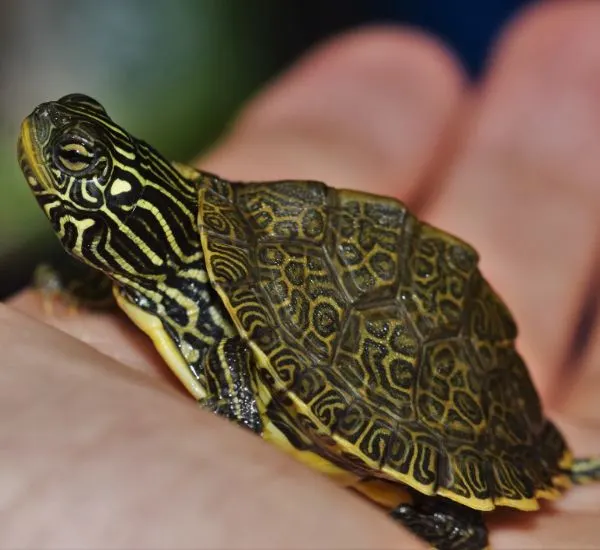
Introduction
Graptemys geographica, a.k.a. Northern Map Turtle, is one of the fastest-swimming freshwater turtle species suitable for home aquariums. These beautiful river-dwellers have intricate shell markings that resemble a map, hence the name.
These active, curious, strong swimmers, born into the Graptemys geographica habitat, which has strong currents, will survive the harshest conditions.
Northern Map Turtle care is more complex than that of other species, so only experienced aquarists can keep them as pets. Following this guide will transform you from a beginner to an intermediate-level hobbyist in no time.
Author’s Note: Check out our post The 14 Types of Freshwater Turtles for even more great semi-aquatic pets!
Creating the Perfect Habitat for a Northern Map Turtle
To satisfy this highly active species outside its natural environment, you must meet specific freshwater turtle habitat requirements, up next.
Tank Size & Water Depth
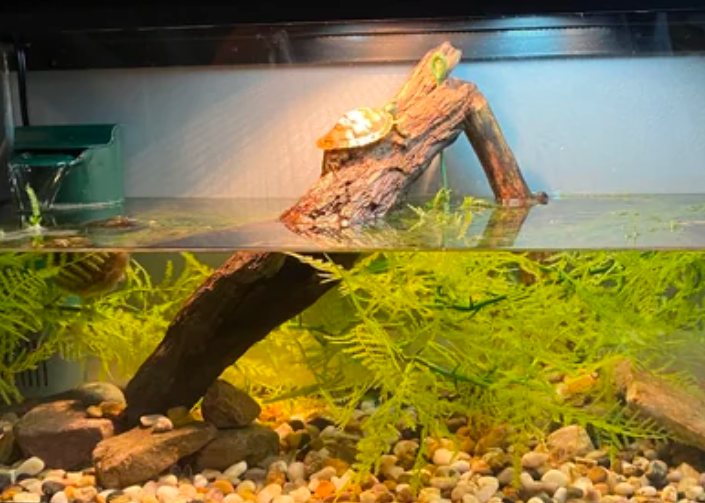
To build the best tank setup for the Northern Map Turtle species, you must measure your pet’s physical features, abilities, and needs.
Adult Map Turtles thrive in larger tanks containing at least 75 gallons of water and a depth 1.5 times their shell length.
Set the water temperature between 72 and 78℉.
Basking & Lighting
As semi-aquatic pets, turtles spend some time in dry spots basking under UVB lighting and heat lamps. Ensure the spot is 85 – 90℉ hot and strong enough to hold your Map turtle’s weight.
Filtration & Water Flow
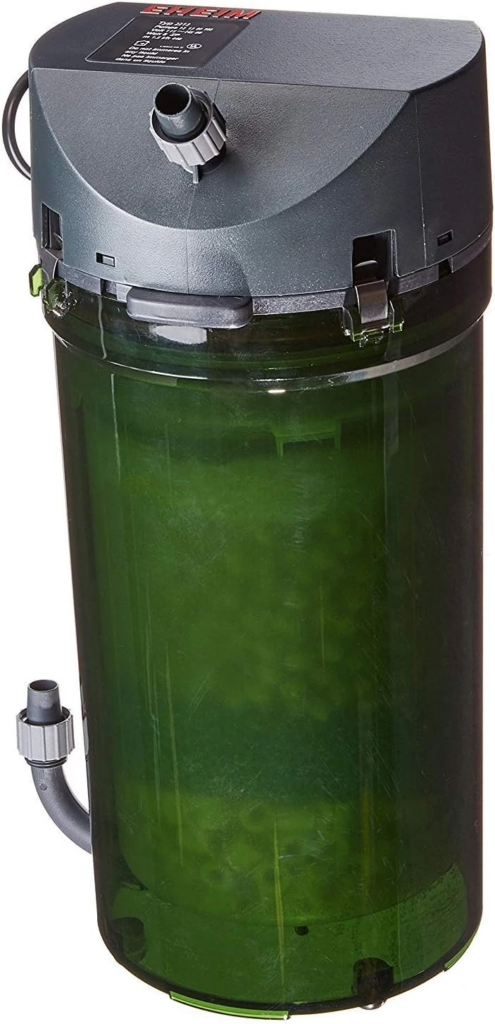
Your aquatic turtle filtration needs will be well met with a high-powered filter for your Northern Map Turtle’s aquarium since they’re strong swimmers used to heavy currents. It’ll also keep the water clean despite their messy eating habits and waste.
For the best result, use a single or double-canister filter. Checkout our post on the 7 Best Filters for Your Turtle Tank & its Gallon Capacity for an in-depth guide on the best turtle tank filtration system.
Substrate & Décor
Balance your need for self-expression through decor with your pet’s needs and comfort. Choose smooth rocks and driftwood for a dynamically aquascaped environment while keeping an open swimming space for their underwater experience.
Understanding Northern Map Turtle Behavior & Personality
Do you have an idea about the Northern Map Turtle’s personality traits? Or is this your first encounter with them?
Whichever it is, here’s the low-down on their fast-moving, inquisitive nature, love for swimming, and specific social behaviors.
Activity Levels
The Graptemys family is filled with active freshwater turtles that love swimming and exploring their surroundings. That’s why they need open swimming spaces in their habitat.
Also be sure to keep your turtle stimulated in an their environment and consider some of the 8 Best Toys for Pet Turtles to Play With which will keep you both entertained!
Interaction with Humans
Map turtles recognize their owners after a few interactions, but that shouldn’t encourage you to overhandle them. Limit your physical contact with your pets to only necessary handling like health and wellness checks.
Basking & Resting Habits
Although they’re strong swimmers, you must not ignore necessary basking behavior in Map Turtles. It helps strengthen their shells and regulates their temperature after spending lots of time underwater.
Exploring the Different Types of Map Turtles
You’re about to see different types of Map Turtles within the Graptemys genus. They share similarities with the northern map turtle, so if you’ve mistaken anyone for the other before now, it’s fine. Let’s straighten out any confusion, up next.
False Map Turtle (Graptemys pseudogeographica)
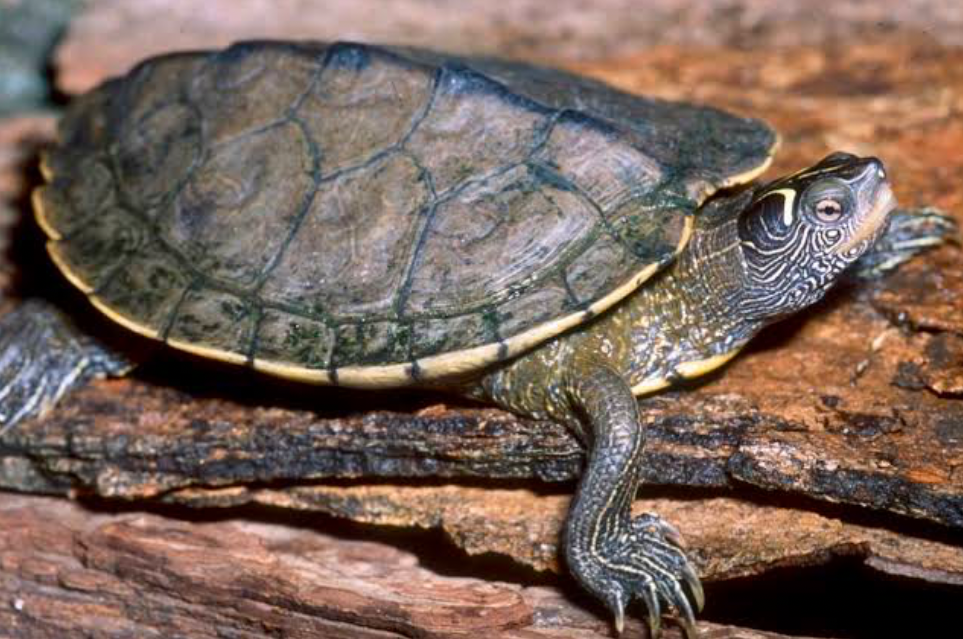
You’ll notice their physically lighter shell markings, the L or S-shaped line behind their eyes, and a less prominent keel.
They’re also less aggressive than other variants and are natives of the Central USA river basins.
Mississippi Map Turtle (Graptemys pseudogeographica kohnii)
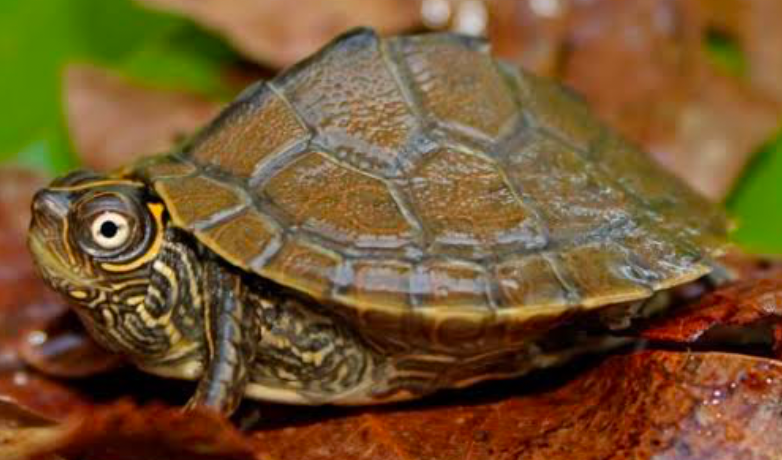
This subspecies of the False Map Turtle is smaller than the Northern Map Turtle and has a more pronounced keel. Its distinctive feature is a small crescent mark behind its eyes and fewer patterns on its shells.
Black-Knobbed Map Turtle (Graptemys nigrinoda)
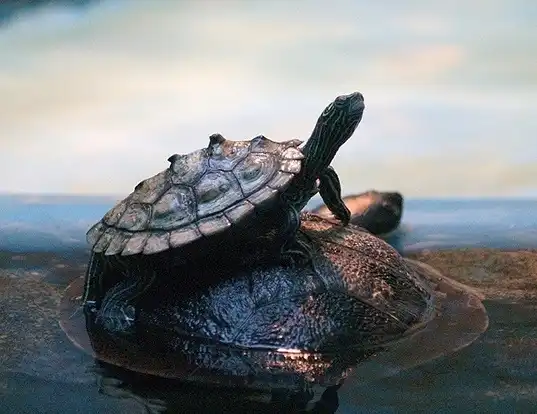
This Alabama river native has a noticeable black projection along its pointed-knob shell ridge and light yellow markings on its skin.
There are many more variants of this family, but these are the most popular species and subspecies. With this Graptemys species guide, you won’t mistake any of these species for the other anymore.
Now that we’re done comparing Map Turtle varieties let’s choose the best companions for the geographica species.
Choosing the Best Tank Mates for a Northern Map Turtle
This species does best alone, but I understand the need for a community of beautiful pets. So, follow these tips to pick the best tank mates for Northern Map Turtles.
Best Companions
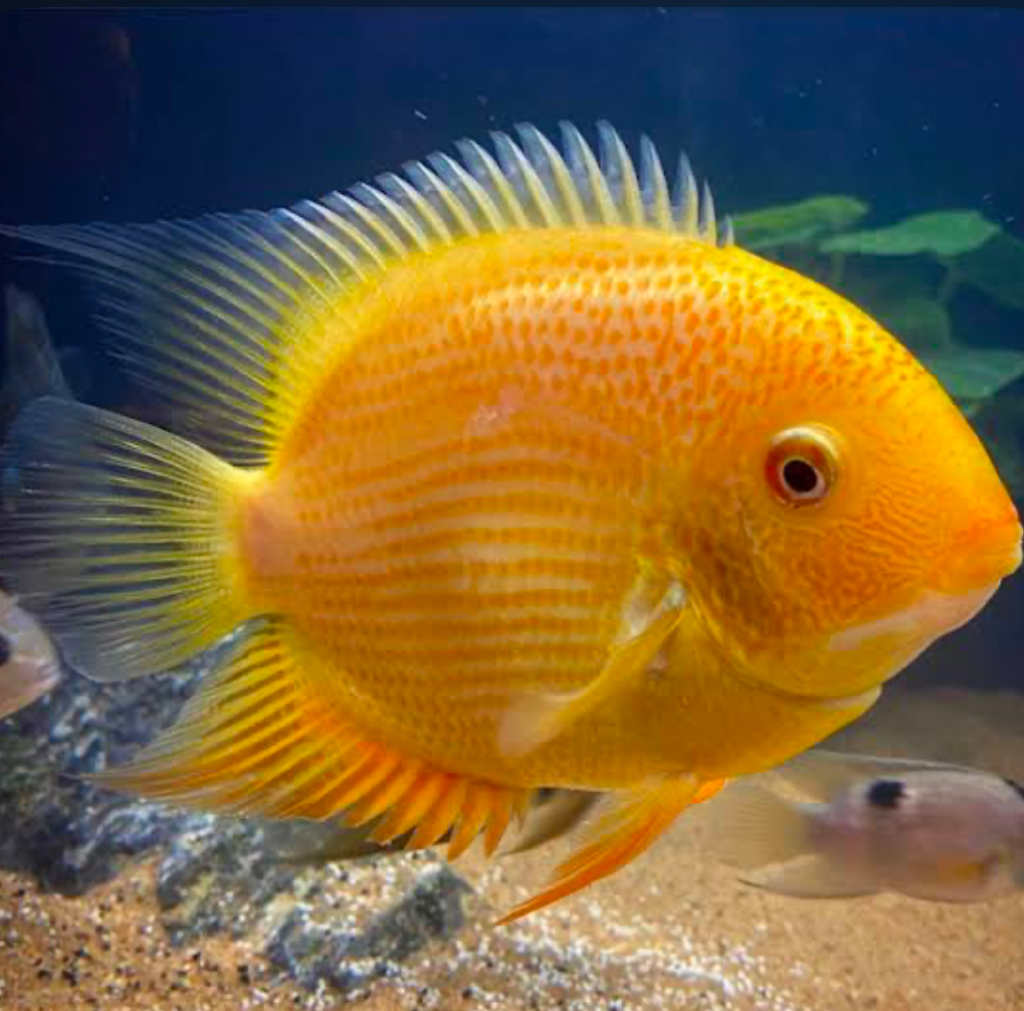
Other map turtles from the Graptemys genus are the best companions for your pets. But if you must mix across species, note that aquatic turtle and fish compatibility only works with specific types of large and/or fast-moving fish like Harlequin Rasboras and Cichlids that can coexist with an active turtle.
Species to Avoid
Slow-moving fish, small turtles, and amphibians would not survive in a tank with Northern Map Turtles. They may end up as food or cause stress for your pets.
Solo vs. Group Housing
It’s not always easy keeping multiple turtles together because they’re largely territorial pets. However, you can achieve harmony with constant checks and specific conditions, such as visual dividers, plenty of space, and separate basking spots.
Without fulfilling these requirements, your Map Turtle tank will become a “war zone,” especially with males fighting for territory.
Feeding the Northern Map Turtle: A Balanced Diet for Growth
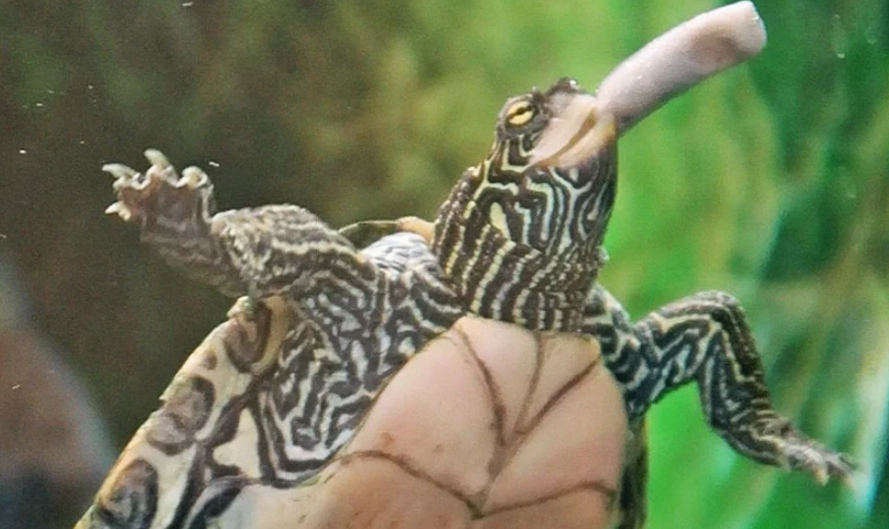
The Northern Map Turtle’s diet is omnivorous. Its preference for carnivorous meals in juvenile years shifts to plant-focused omnivorous foods in adulthood.
Your job as their handler is to provide variety for proper shell and overall health throughout their lives.
Dietary Need
When they’re young, protein-rich sources such as insects, fish, and crustaceans are the best foods for Graptemys geographica. Sinking Pellets rich in protein like these, Found Here On Amazon, are ideal staples replacing the need to find lots of insects. Diverse foods like these will help strengthen their muscles and develop their bones with calcium and Vitamin D3.
After maturity, Northern Map Turtles need plant-based meals to boost their immunity.
Best Foods
Feed them snails, shrimp, commercial turtle pellets, and leafy greens for varied nutrients.
| Leafy Greens & Aquatic Plants | duckweed, collard greens |
| Calcium | cuttlefish bone, powdered calcium supplements |
| Protein | Bloodworms, Earthworms, Feeder Fish |
Author’s Note: Check out our Complete Guide To Turtle Food: What To Feed And Why It Matters for detailed food recommendations!
Feeding Schedule
The routines for feeding freshwater turtles depend on their age. Juveniles should eat daily at dusk or dawn, while adults can eat only 3 to 4 times weekly.
Breeding Northern Map Turtles: What You Need to Know
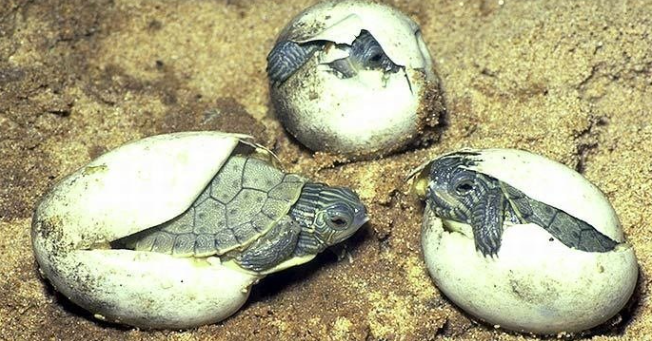
You must follow these strict practices when breeding Northern Map Turtles to get the healthiest juveniles that can transition into adulthood.
Let’s start with a brief insight into the breeding process, then move to nesting requirements and hatchling care.
Breeding Setup
Prepare the tank for hibernation before they begin mating. Within 2 to 3 weeks, drop the temperature to 50 – 55 degrees F. Reduce the water depth to 1x their shell health for easy access to the basking area.
Add a 12” deep nesting box filled with a damp sandy-soil mix.
Now, let’s talk about mating.
Mating Behavior
First, you’ll select the breeding adults by choosing a male and female who are at least 3 to 4 years old. Note that the males are smaller at 4 – 6 inches than the females at 7 – 10 inches.
Males caress the females’ faces with their front claws to show interest. If she accepts, she swims towards him and allows mating underwater.
Nesting & Egg Incubation
The female Northern Map Turtle will swim to the nesting box to lay 2 – 3 clutches of eggs, each containing 6 – 12 pieces. Wait for her to finish laying before incubating turtle eggs.
Don’t rotate the eggs when placing them in the incubator. Set the following parameters in the incubator and wait 60 – 80 days for the eggs to hatch.
| Female | 77 – 82℉ |
| Male | 87 – 88℉ |
| Mixed | 83 – 86℉ |
Hatchling Care
Hatchling turtle care differs from egg care but is similar to adult maintenance. Reset the water and basking area temperature to the normal levels stated above.
Constant water changes are necessary to ensure optimal quality fit for sensitive juveniles, and a protein-rich diet is recommended for good development.
Common Health Issues & How to Prevent Them in Northern Map Turtles
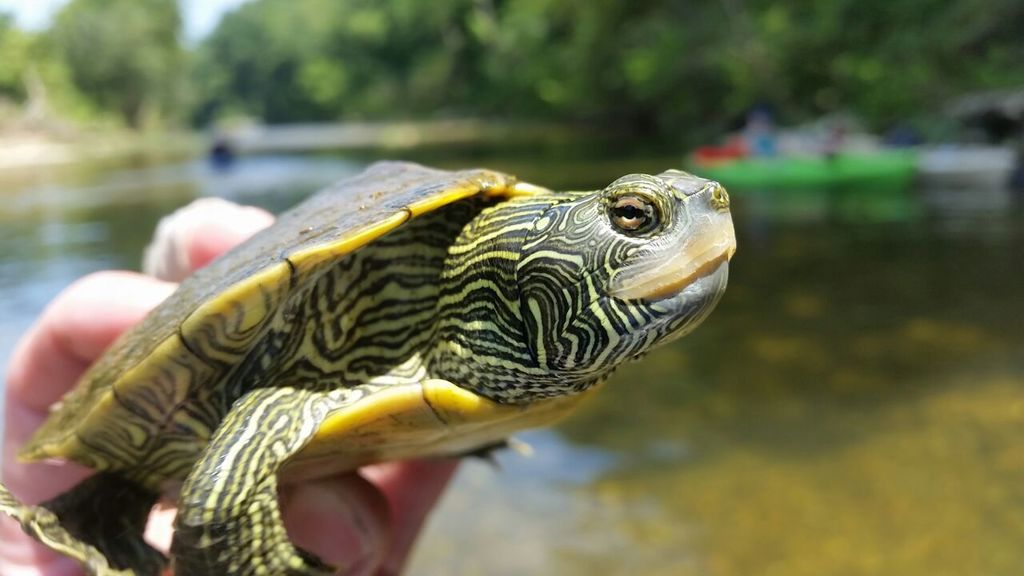
Giving your pets the best care reduces the risk of illness, but knowing the symptoms, treatment, and preventative measures for the most frequent Northern Map Turtle health concerns is a sign of responsible ownership.
Shell Health Issues
Map turtles may experience fungal infections, pyramiding, and deformities due to a poor diet, lacking calcium and Vitamin D3, dangerous habitats, and untreated cracks.
Preventing shell diseases in turtles depends on the efficiency of their environment and diet. Scroll up for optimal maintenance tips.
Respiratory Infections
Improper temperatures and poor water quality lead to respiratory infections. The ideal prevention is by setting my optimal temperatures and keeping the water pristine with top-quality filters.
Parasites & Skin Issues
Poor water quality breeds parasites, which cause skin issues and affect your Map Turtle’s mood.
This guide contains the best health practices for aquatic turtles. Read it as many times as necessary to maintain your pets properly.
Lifespan & Long-Term Care: How to Ensure a Healthy Map Turtle
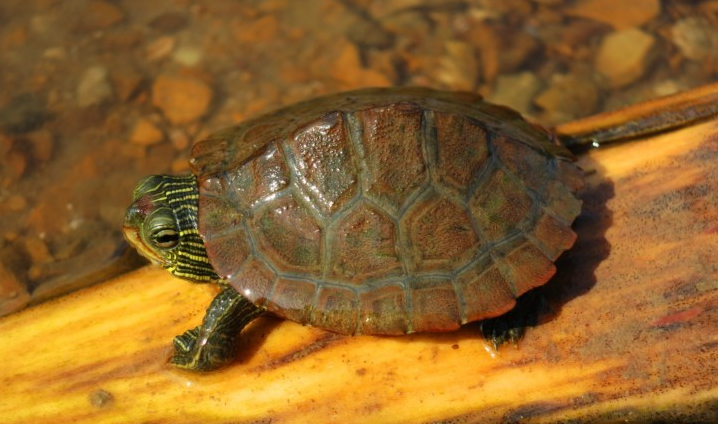
You can extend a Northern Map Turtle’s lifespan between 20-30 years with proper care and the necessary adjustments as they age. Here’s how to achieve this:
Tank Size Upgrades
As they age, increase their tanks from small/medium sizes of 20 to 45 gallons to larger 75+ gallons.
Dietary Changes Over Time
Switch from a high protein to more plant-based foods as they age.
Routine Health Checks
Keeping Map Turtles healthy is a full-time job, requiring daily monitoring of their shell growth and health and observing their activity levels and changes. Luckily, this long-term turtle care guide is a nice starting point.
Conclusion
Remember that the Northern Map Turtle is the best turtle species for advanced keepers. So, beginners, beware, study up first.
If you’re up for a challenge despite the level of care required to keep them, you’d love their active swimming nature and distinct map-like shell patterns. Use this responsible Map Turtle care guide to give them the longest and healthiest life possible in an aquarium.
You can do more research and ensure you’re committed to owning a Northern Map Turtle before adopting one.
Help fellow hobbyists by leaving a useful comment in the box below.

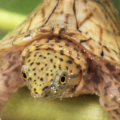
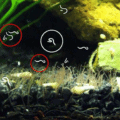
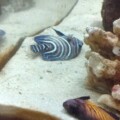
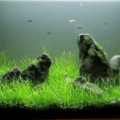
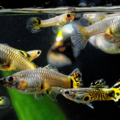
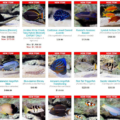
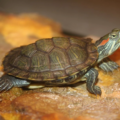
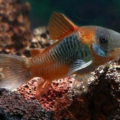

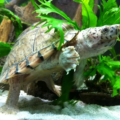
1 thought on “Northern Map Turtle (Graptemys geographica): The Fast-Swimming River Explorer”